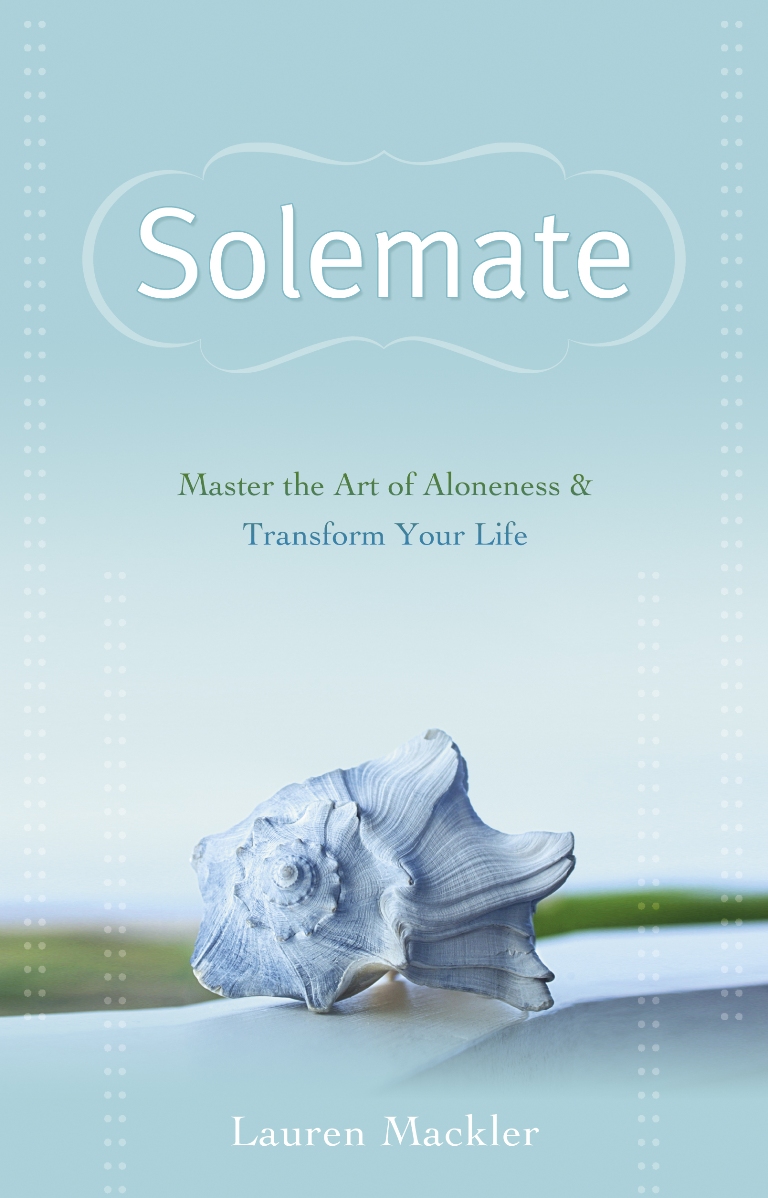“By embracing your aloneness and reclaiming your innate wholeness, you create new results in every aspect of your life.” - Lauren Mackler
A Note from Dr. Northrup
I often say that, physiologically, midlife presents you with the perfect opportunity to reinvent yourself, especially if there are aspects of your life that you wish were different. Many women find themselves alone at midlife—something they never expected. This happened to me. And although it took a while, I’m much happier today than I’ve ever been. Why? Because I learned what lights me up—what I need to live a life full of joy and pleasure.
This also meant mastering what Lauren Mackler, my guest author this month, calls the art of aloneness. It’s something women of every age should become skilled at, regardless of whether they’re in a relationship. I agree fully with the message in her inspiring and insightful book Solemate: Master the Art of Aloneness and Transform Your Life If you want to be truly happy in your relationships, you have to become “your own cherished solemate.”
– Christiane Northrup, M.D.
You can sign up and read on to learn more. – Dr. Christian Northrup’s Newsletter.
Solemate Master the Art of Aloneness and Transform Your Life
By Lauren Mackler
Master the Art of Aloneness and Transform Your Life
By Lauren Mackler
Many people spend years waiting for Prince or Princess Charming to make them happy and complete. Others settle for unfulfilling relationships out of fear of being alone. Mastering the art of aloneness is about achieving mastery of your life so you can experience a sense of wholeness and well being whether you’re on your own or in a relationship. It’s about treating yourself well, and shedding the old beliefs and behaviors that limit your ability to realize your greatest potential. It’s about becoming your own cherished solemate.
When we’re born, we are whole, integrated human beings filled with tremendous potential. We feel good about ourselves and are able to express the full range of human emotions. As we grow up, we adapt to the peculiarities of our families by adopting habitual patterns of thought and behavior, some of which erode our innate wholeness and self-esteem. We carry these patterns into adulthood, and they shape our lives, our feelings about ourselves, and our relationships with others.
In one way or another, just about every family is dysfunctional. Everyone emerges from their family of origin with a distinctive set of issues. Within some families, children grow up experiencing extreme dysfunctions such as physical, verbal, or sexual abuse. Others experience subtler dysfunctions that shape their core beliefs and behavior—maybe taboos that impede their ability to express their feelings, frequent criticism that erodes their self-esteem, or rigid rules that inhibit self-expression. We are all products of our families’ unique patterns and dysfunctions. Some of these patterns are like viruses, infecting our lives and sense of well being. And, until we become aware of what they are and how to move beyond them, none of us is truly whole.
 Mastering the art of aloneness is about reclaiming your innate wholeness. It’s a process that involves understanding where your self-defeating patterns come from and how to move beyond them. It means uncovering and retrieving your authentic self—the person you really are beneath the layers of your life conditioning—and living in a conscious way so you can achieve the results that you want from life and feel complete and happy on your own.
Mastering the art of aloneness is about reclaiming your innate wholeness. It’s a process that involves understanding where your self-defeating patterns come from and how to move beyond them. It means uncovering and retrieving your authentic self—the person you really are beneath the layers of your life conditioning—and living in a conscious way so you can achieve the results that you want from life and feel complete and happy on your own.
If you don’t feel whole you’re always going to be seeking someone else to complete you. Take the example of a man who grows up in a family where he’s never allowed to express joy or enthusiasm; he’ll be looking for someone else to bring those expressions into his life. Or a woman who never feels secure on her own—she’ll spend her life seeking security from others. In my coaching practice, I’m amazed by the number of people who come to me with little understanding of the human conditioning process and how it affects their lives. Many have invested countless hours and dollars in self-help approaches focused on changing their behavior—but they still struggle with the same issues over and over because they haven’t addressed their family-of-origin issues. Others spend years in therapy talking about their families. They may come away with an intellectual understanding of their families and dysfunctional patterns, but they lack the strategies to change them. The challenge is to connect the dots. That means focusing in on the core beliefs and behavioral patterns you adopted in your family of origin and developing workable strategies that will help you change them.
 Mastering the art of aloneness is not about being alone. It means living a life in which you feel whole and happy, and can take care of yourself emotionally and financially. It involves embracing aloneness as an opportunity to develop the self-awareness and life skills needed to live a full and gratifying life. Pursuing self-mastery not only enhances the quality of your relationship with yourself, but it changes your relationships with others. Instead of expecting another person to make you whole, you engage in relationships with a sense of being complete on your own. Self-sufficiency builds self-esteem, allowing you to participate in relationships with others out of conscious choice, rather than out of neediness or fear of being alone. By embracing your aloneness and reclaiming your innate wholeness, you create new results in every aspect of your life. Below are a few of many steps you can take to strengthen your relationship with yourself and use your “aloneness” to develop greater self-esteem, personal fulfillment, and financial security.
Mastering the art of aloneness is not about being alone. It means living a life in which you feel whole and happy, and can take care of yourself emotionally and financially. It involves embracing aloneness as an opportunity to develop the self-awareness and life skills needed to live a full and gratifying life. Pursuing self-mastery not only enhances the quality of your relationship with yourself, but it changes your relationships with others. Instead of expecting another person to make you whole, you engage in relationships with a sense of being complete on your own. Self-sufficiency builds self-esteem, allowing you to participate in relationships with others out of conscious choice, rather than out of neediness or fear of being alone. By embracing your aloneness and reclaiming your innate wholeness, you create new results in every aspect of your life. Below are a few of many steps you can take to strengthen your relationship with yourself and use your “aloneness” to develop greater self-esteem, personal fulfillment, and financial security.
• Learn about and develop who you are: Imagine how life would be if we all put as much energy into developing a healthy and loving relationship with ourselves as we do in our relationships with others. Personal-development work (coaching, workshops, therapy, etc.) is a process that involves deep self-examination and awareness of who you are, how you behave, and the results your actions generate. With greater awareness comes a more conscious choice of who you want to be and how you want to behave and interact with others. It involves making deliberate decisions about the results you want to achieve in your life and relationships. Personal transformation requires a high level of awareness in your day-to-day life. It means living deliberately so that you can override the negative patterns of your life conditioning, change your limiting beliefs and behaviors, and bring your life goals to reality.
 • Build an inner support system: You develop an inner support system by incorporating activities into your life that replenish your inner resources and maintain your emotional, physical, and mental health. Your inner support system should meet two specific criteria: These are activities that you do on a regular basis and can do independently of anyone else. By building your inner support system, you’ll be developing the inner resources you need to achieve your life goals, while practicing self-love and building your self-esteem. As you experience the benefits of your efforts—whether it’s a sense of inner peace, a healthier body, higher energy, or greater self-confidence—it will reinforce the value of what you’re doing. In addition, you’ll be mastering the art of aloneness by taking responsibility for creating your own well being, instead of depending on others to provide it for you. Examples of activities that build your inner support system include stress-reducing strategies such as getting enough sleep and exercise, meditating, scheduling leisure activities, extending compassion to yourself through supportive “self talk” (“great job!”, “you’re magnificent!”, etc.), and maintaining a diet that supports your physical and emotional well being.
• Build an inner support system: You develop an inner support system by incorporating activities into your life that replenish your inner resources and maintain your emotional, physical, and mental health. Your inner support system should meet two specific criteria: These are activities that you do on a regular basis and can do independently of anyone else. By building your inner support system, you’ll be developing the inner resources you need to achieve your life goals, while practicing self-love and building your self-esteem. As you experience the benefits of your efforts—whether it’s a sense of inner peace, a healthier body, higher energy, or greater self-confidence—it will reinforce the value of what you’re doing. In addition, you’ll be mastering the art of aloneness by taking responsibility for creating your own well being, instead of depending on others to provide it for you. Examples of activities that build your inner support system include stress-reducing strategies such as getting enough sleep and exercise, meditating, scheduling leisure activities, extending compassion to yourself through supportive “self talk” (“great job!”, “you’re magnificent!”, etc.), and maintaining a diet that supports your physical and emotional well being.
 • Develop an outer support system: An outer support system refers to people and environments that support who you really are, and provides the connection and assistance of others. Developing caring and supportive relationships is a way of nurturing yourself. However, not all people have what it takes to be supportive, and not all unsupportive people can be avoided—for example, sometimes you can’t escape family members and co-workers. The idea here is to identify the qualities that support you, spend time with people who embody those qualities, and, as much as possible, avoid people who are detrimental to you and your personal development. Another important aspect of your outer support system is utilizing external resources to help you achieve your full potential (a holistic physician, nutritionist, fitness trainer, life coach, psychotherapist, financial planner, etc.).
• Develop an outer support system: An outer support system refers to people and environments that support who you really are, and provides the connection and assistance of others. Developing caring and supportive relationships is a way of nurturing yourself. However, not all people have what it takes to be supportive, and not all unsupportive people can be avoided—for example, sometimes you can’t escape family members and co-workers. The idea here is to identify the qualities that support you, spend time with people who embody those qualities, and, as much as possible, avoid people who are detrimental to you and your personal development. Another important aspect of your outer support system is utilizing external resources to help you achieve your full potential (a holistic physician, nutritionist, fitness trainer, life coach, psychotherapist, financial planner, etc.).
• Take financial control: If you’re a woman, don’t fall into the trap of imagining that you’d be better off with a mate to support you financially—a limiting belief that many women still hold. In truth, 90 percent of all American women will be in charge of their own finances at some point in their lives. As Leslie Bennetts points out in The Feminine Mistake: “In striving to become a fully mature, fully realized human being, there is no substitute for taking complete responsibility for your own life.” Make a list of your monthly expenses and income. If you live beyond your means, you need to alter your lifestyle or develop a plan for earning the money to support it. Being financially dependent on another person is a risk; if that person disappears from your life, so does your financial security and quality of life.
 • Do work you love, in which you can excel: The smaller the gap between who you are in your personal life and who you are at work, the happier you will be. A job aligned with your innate strengths and passions makes going to work a joy, versus a daily source of frustration. Many people settle for a job or career that is unsatisfying or miserable. They’re held back from pursuing their dream job out of a fear of change or failure—or simply by not knowing what other career they can do. Staying in a job you dislike not only reduces your life quality, but it can affect your health and well-being. Chronic stress can compromise your immune system, making you more susceptible to illness. If you’re unsure about what kind of work is best suited to your innate personality traits, skills, and passions—or you know what you want to do but are unclear about how to make it happen—hiring a good career coach can help.
• Do work you love, in which you can excel: The smaller the gap between who you are in your personal life and who you are at work, the happier you will be. A job aligned with your innate strengths and passions makes going to work a joy, versus a daily source of frustration. Many people settle for a job or career that is unsatisfying or miserable. They’re held back from pursuing their dream job out of a fear of change or failure—or simply by not knowing what other career they can do. Staying in a job you dislike not only reduces your life quality, but it can affect your health and well-being. Chronic stress can compromise your immune system, making you more susceptible to illness. If you’re unsure about what kind of work is best suited to your innate personality traits, skills, and passions—or you know what you want to do but are unclear about how to make it happen—hiring a good career coach can help.
As you take the first steps toward mastering aloneness, it’s important to recognize that you’ll slip up. Imagine how a typical smoker quits smoking. She throws away that first pack of cigarettes. Then she might weaken and buy another pack, then just smoke a few cigarettes, then give it up for another few days or weeks, then start up again. And then, one day, she’s just done with it. She’s tried to quit, and finally she just stops. That back-and-forth is part of the process. Like quitting smoking, mastering aloneness is about changing your habitual patterns of behavior. As you begin the process, it’s important to be gentle with yourself. When you slip up, think of it as simply getting more information about what doesn’t work for you. Making a commitment to mastering the art of aloneness means accepting the fact that you will slip up; treating yourself with love and compassion when you do, and then moving forward in becoming the person you were born to be.
© 2009 Lauren Mackler all rights reserved
Reprinted with permission from Dr. Christiane the Women’s Wisdom Circle at www.drnorthrup.com. Reproduction in whole or in part without permission is prohibited.
Christiane Northrup, M.D., a board-certified ob/gyn, is a visionary pioneer, beloved authority in women’s health and wellness, and the author of the ground breaking New York Times bestsellers Women's Bodies, Women’s Wisdom and The Wisdom of Menopause. Her third book, Mother-Daughter Wisdom, was voted Amazon’s #1 book of the 2005 (in two categories). Her latest books, The Secret Pleasures of Menopause and The Secret Pleasures of Menopause Playbook, teach how to experience joy, pleasure, prosperity, fulfillment, and vibrant health.
Following a 25-year career in both academic medicine and private practice, Dr. Northrup now devotes her time to helping women truly flourish on all levels through tapping into their inner wisdom.
Through her exclusive Women’s Wisdom Circle, Dr. Northrup shares cutting-edge medical and lifestyle advice. For more information about Dr. Northrup and her Wisdom Circle go to www.DrNorthrup.com.
 There are many seminars, books, and articles about how to be an effective leader. But what is often missing from these resources is how to strategically shape and manage relationships with superiors. As a result, many people harbor feelings of stress, overwhelm, frustration, or resentment toward their boss, but keep them hidden for fear of reprisal. Over time, their motivation and performance diminish, putting their job at risk.
Below are some practical strategies for building a mutually productive and respectful relationship with your boss, managing expectations and workloads, and positioning yourself as an exceptional leader within your organization.
There are many seminars, books, and articles about how to be an effective leader. But what is often missing from these resources is how to strategically shape and manage relationships with superiors. As a result, many people harbor feelings of stress, overwhelm, frustration, or resentment toward their boss, but keep them hidden for fear of reprisal. Over time, their motivation and performance diminish, putting their job at risk.
Below are some practical strategies for building a mutually productive and respectful relationship with your boss, managing expectations and workloads, and positioning yourself as an exceptional leader within your organization.









![iStock_000000870661Small[1]](http://static1.squarespace.com/static/5509a3d7e4b00460cea67f14/55905084e4b0f86d9aee635e/55905093e4b0f86d9aee68d5/1265982010000/iStock_000000870661Small1.jpg?format=original)



![iStock_000009405832Small[1] iStock_000009405832Small[1]](http://static1.squarespace.com/static/5509a3d7e4b00460cea67f14/55905084e4b0f86d9aee635e/55905092e4b0f86d9aee6844/1263912865000/iStock_000009405832Small1.jpg?format=original)













